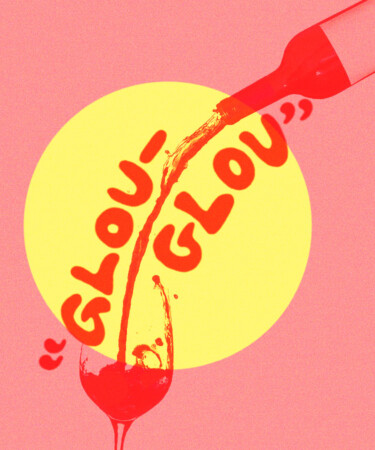While wine terms can often sound stuffy or intimidating, with words like “legs,” “fleshy,” or “stemmy” being commonplace in tasting room chatter, there is one phrase that stands apart in both popularity and how fun it is to say: glou-glou. Rather than requiring knowledge of complex winemaking methods or a sommelier certification to unpack this term, understanding the meaning of glou-glou is just about as easy as saying it. The word is a French onomatopoeia that translates to “glug glug,” referring to both the sound of wine rapidly pouring out of a bottle’s neck and of the wine being guzzled down by an enthusiastic consumer. So, by its most basic definition, glou-glou describes ultra-quaffable wines that go down easy. But even though the term is meant to be playful and used in an easygoing way, there’s still some history and nuance to uncover when it comes to its evolution.
The first documented appearance of the term was in French playwright Molière’s 1666 play “The Doctor Despite Himself,” but it reappeared in early aughts pop culture in the context of natural wine. While the natural wine movement is associated with many aspects of the industry including farming practices and winemaking methods, the wave is also about accessibility, and bringing lovable, easy-drinking wines to more people. The concept of glou-glou is the epitome of this effort: These wines are meant to be easily enjoyed, so people can drink them without food or feeling intimidated by over-analytical tasting notes. Now there are even wine bars and shops named in honor of the phrase, like Amsterdam watering hole GlouGlou and labels like Las Jaras Glou-Glou.
While the word can be applied to any category of wine like rosé or orange wines, glou-glou is most commonly used to describe juicy, chillable reds. These wines are fruit-forward and low in tannin with refreshing acidity. Reds from France’s Beaujolais region are often associated with the term, as the Gamay-based wines from this area reliably offer these characteristics. While crushable chillable reds are rising in popularity and are now being made all over the world, it felt right to go straight to the source and dive deeper into the term with Laura Lardy, a fourth-generation Beaujolais producer.
“In my opinion,” says Lardy, “glou-glou means wines that are digestible and light on the palate. They are often fruity or floral, and can be drunk dangerously quickly!”
Lardy doesn’t quite recall exactly when she first heard the term or how it rose so quickly in popularity over the past few years, but believes the primary motivation behind glou-glou is to recognize the lighter-bodied, natural wines that didn’t necessarily fit into previously defined categories of wine. When it comes to crafting a glou-glou wine, Lardy explains that the grape variety, terroir, and winemaking practices can all contribute to achieving the signature style. In terms of grapes, thin-skinned red varieties like Gamay, Trousseau, or Mencia make great candidates, since they produce wines low in tannin. While tannins offer great structure to a wine, the bitter, astringent feeling that tannins evoke can make a wine challenging to drink. This is why many prestigious wines like Napa Cab or Barolo are enjoyed with some age on them, since the wines need time for the tannins to settle down. More chuggable, glou-glou wines, though, are unburdened by intense tannins, and are meant to be consumed young with ample primary aromas and flavors.
Wines can also be made in the glou-glou style by implementing certain winemaking practices such as gentle pressing with minimal extraction and carbonic maceration (a fermentation method that emphasizes a wine’s fruity characteristics and minimizes tannin). Beaujolais is famed for its use of carbonic maceration, and Lardy implements this technique in line with the region’s tradition, making wines with semi-carbonic maceration of whole grapes in concrete vats. The bottle in her portfolio that she thinks most captures the spirit of glou-glou is her Beaujolais-Villages Gourde á Gamay, made to be a pleasant, uncomplicated everyday wine.
Glou-glou wines often face the stereotype that they all taste the same and can be one-note. But even though these wines are intended to be whimsical and fun, that doesn’t mean they aren’t well crafted and representative of a place. Lardy makes a point to vinify the Gourde á Gamay wine in this style “while respecting the terroir,” and works in several different cru-level villages within Beaujolais including Chénas, Moulin á Vent, and her hometown of Fleurie to capture the unique properties of where the grapes are grown. “I like to have cuvées that each have their own personality,” Lardy adds.
If you’re interested in these kinds of quaffable wines, then glou-glou is a great descriptor to use when speaking with a sommelier or someone at your local wine shop. Just keep in mind the term is meant to be fun and accessible — which is a good thing, since it’s almost impossible to sound pretentious while saying it.
